The Storied Trees of Oxford
A stroll around the fabled city reveals botanical delights
By Michael Walsh
Never say there is nothing beautiful in the world anymore. There is always something to make you wonder in the shape of a tree, the trembling of a leaf.
Albert Schweitzer
When one thinks of Oxford England, several things immediately come to mind: cobbled lanes, alleyways and eight hundred year-old buildings designed by famous architects such as Christopher Wren.
There is, however, another facet of Oxford’s beauty: its old storied trees.
Largely overlooked by visitors and many residents, they still stand centuries after they were planted – most of them unmarked in meadows with their massive trunks and enormous crowns.
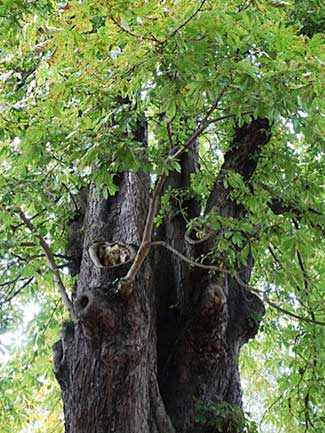
Horse Chestnut
During a recent trip to England, I came across an old street map of Oxford that had a section entitled Remarkable Trees indicating their locations. On a cold drizzly Saturday afternoon, camera in one hand and the map in my jacket pocket we set out to photograph those we could find. It was difficult to locate some of them – the meadow paths deviated in directions that were not indicated on the map.
The most famous trees however, are growing in gardens that are open to the public once every two years. Specifically, a plane tree (Plantanus orientalis) in Christ Church’s Pococke Garden – widely thought to be the inspiration for Charles Dodson’s Jaberwocky, writing under the pen name Lewis Carroll, while he was employed as a mathematics lecturer at Christ Church.
A second famous tree, a horse chestnut (Aesculus hippocastanum), grows in the Dean’s Garden – supposedly, the tree in which the Cheshire Cat first appeared in Alice in Wonderland.
What follows is a sampling of those we could locate, in the meadows and throughout the city, and their fascinating stories.
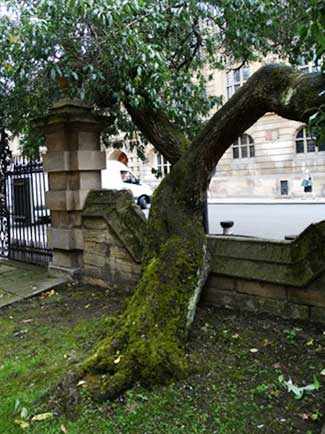
Almond tree
Almond Tree (Prunus dulcis)
A beautiful pink almond tree stands next to the University Church of Saint Mary the Virgin. Related to the peach tree it bears an edible almond fruit that is the basis of almond milk.
Greek legend tells the story of Demophoon and Phyllis, childhood sweethearts that became separated without their will. In her grief, Phyllis took her life. The gods intervened, and rather than let her die, turned her into an almond tree. When Demophoon eventually returned, he wrapped his arms around the tree crying for his lost sweetheart. Upon hearing this, the tree blossomed into a thousand white flowers that eventually turned pink – a colour the blossoms display to this very day.
Dawn Redwood (Metasequoia glyptostroboides)
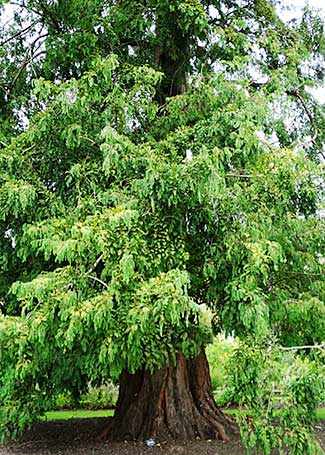
Dawn Redwood
“One of the most exciting discoveries in the plant world during the last century was undoubtedly that of the deciduous conifer, the Dawn Redwood, Metasequoia glyptostroboides.”
“In 1946, acting on a tip-off and sight of some fragmentary material, Professor Cheng of the National Central University, China, sent an expedition to the remote village of Mo-tao-chi in Szechuan province to collect a complete set of specimens from a stand of recently-discovered, unidentified trees.”
“After consultation with Dr Hu, China’s leading dendrologist, it became obvious that the trees belonged to the genus Metasequoia, hitherto only known from fossil evidence dating back 100 million years, and thought to have been extinct for 5 million years.” Cambridge University, Botanic Gardens
Luckily, those of us living in Westmount can enjoy the park’s Dawn Redwood growing next to the children’s playground.
Bobart’s Yew
There is a Yew-tree, pride of Lorton Vale,
Which to this day stands single, in the midst
Of its own darkness, as it stood of yore…This solitary Tree! – a living thing
Produced too slowly ever to decay
Of form and aspect too magnificent
To be destroyed.
William Wordsworth, Yew-Trees
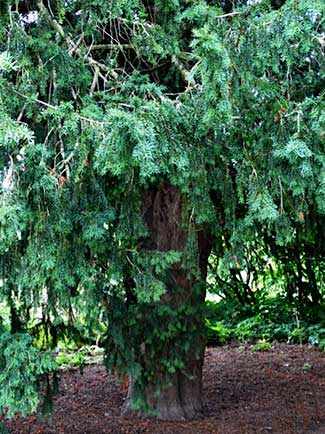
Bobart’s Yew
A spectacular Yew planted in 1645 by Jacob Bobart, a botany professor at the University of Oxford and ‘keeper of the phyfick-garden’ – today known as the Botanic Gardens.
The Yew was used extensively in topiary gardening in England and France during the seventeenth century. Also known as the ‘tree of death’ – the needles contain toxins (taxanes) that are fatal to humans. Christian belief suggests that Christ was crucified on a yew.
Interestingly their toxicity lies in their inhibition of cell division (mitosis) – and their molecular structures are currently used in cancer research.
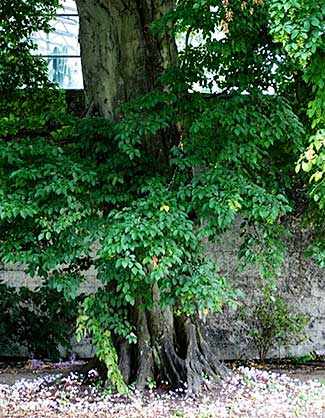
Hornbeam
Hornbeam (Carpinus betulus)
A beautiful old Hornbeam growing next to an ancient stone wall. The tree’s name reflects its hard word – Old English ‘horn’ (hard) and ‘beam’ (tree).
Since Roman times the trees’ wood has been used to yoke cattle.
In England during May-Day celebrations, Hornbeam branches are placed over the doorways of sweethearts to display their devotion to one another.
Austrian Black Pine (Pinus nigra) – Tolkien’s favourite tree
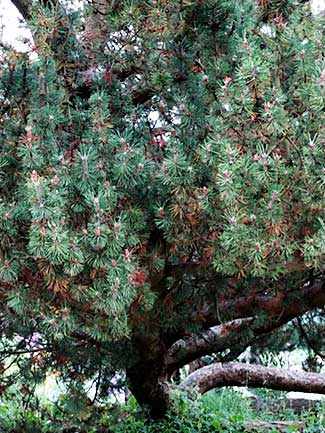
Austrian Black Pine
Tolkien’s favourite tree at the Botanic Garden of Oxford was an Austrian Black Pine he named ‘Laocoon’.
It is said to have been planted in 1799 from a seed collected in Austria by John Sibthorp, an Oxford professor of botany.
Due to safety reasons, the original tree was cut down in 2014 after two large branches collapsed. In its place, another magnificent black pine flourishes.
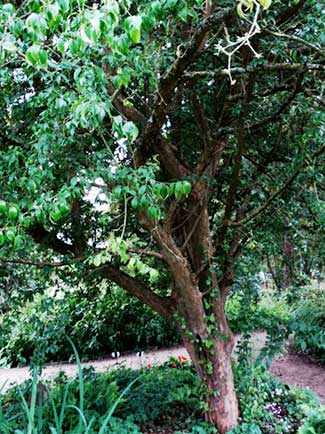
Lyra’s Cherry
Lyra’s Cherry
Everything has a meaning, if only we could read it.
Philip Pullman, Lyra’s Oxford
A cherry tree featured in Philip Pullman’s trilogy Lyra’s Oxford.
The orphaned heroine Lyra’s adventures occur in an Oxford college while under the care of its headmaster.
Images: Michael Walsh
 Read other articles by Michael Walsh
Read other articles by Michael Walsh

Michael Walsh is a long-time Westmount resident. He is happily retired from nearly four decades in the field of higher education technology. A “professional student” by nature, his academic training, and publishing, include statistical methodology, mycology and animal psychology. During this period, he was also an officer in the Canadian Armed Forces. Prior to moving to Montreal, he was contracted by the Ontario Ministry of Education evaluating bilingual primary and secondary school programs. Today, he enjoys spending time with his (huge) Saint Bernard while discovering the city’s past and sharing stories of the majestic trees that grace the parks and streets. He can be contacted at michaelld2003@hotmail.com or through his blog Westmount Overlooked



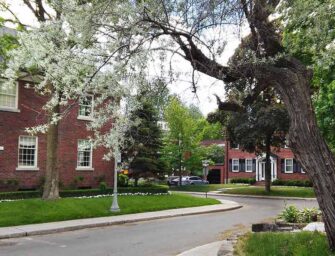

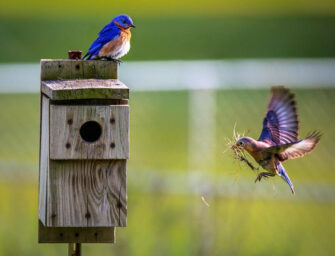








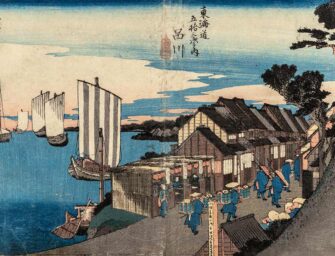







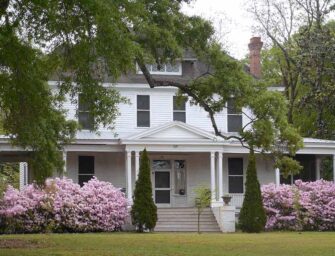








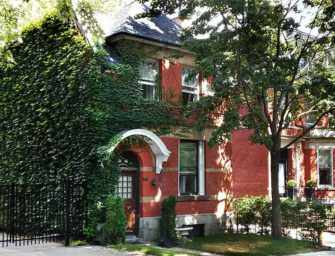
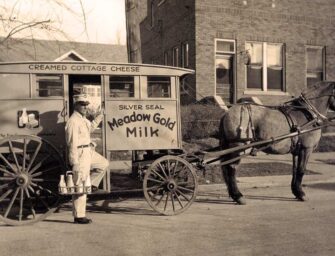


This beautifully combines exquisite photos with equally eloquent words.
Love all the literary references to these marvellous Oxford trees. Tree of life, Druidic groves, even the Cheshire Cat’s chestnut, trees have always been our muses and inspirers as you article shows us. Thanks for this lovely Oxford excursion….